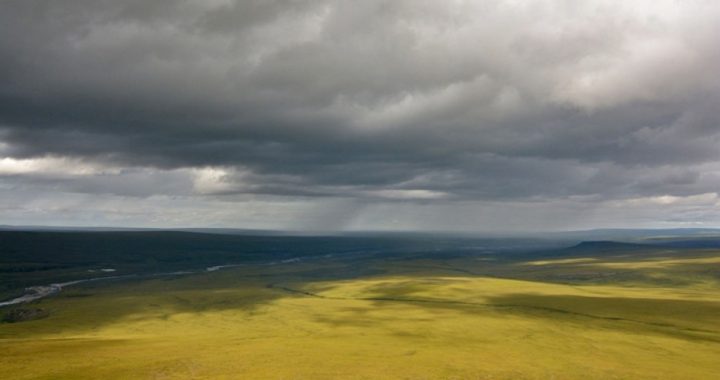
Following a six-day trip to northern Alaska, Trump’s Interior Secretary Ryan Zinke signed an order on Wednesday in Anchorage that reverses a 2013 Obama administration executive order. That 2013 order removed half of the immense National Petroleum Reserve-Alaska (NPRA) on Alaska’s North Slope from consideration for energy development. Said Zinke:
This is land that was set up with the sole intention of oil and gas production; however, years of politics over policy put roughly half of the NPR-A off limits. Using this land for its original intent will create good paying jobs and revenue for our Northern-most city and strengthen our energy and national security. Working with the Alaska Native community, Interior will identify areas in the NPR-A where responsible energy development makes the most sense and devise a plan to extract resources…. This order in effect makes Alaska open for business.
Those resources, both crude oil and natural gas, are immense. The last time a serious study was done of recoverable reserves, the USGS estimated there were 10 billion barrels of crude buried beneath the Alaskan tundra. That study, done in 1998, became grossly outdated with the advent of fracking technology and other breakthroughs in energy development, with some estimates now putting potential reserves in NPR-A and the coastal plain of the Alaskan National Wildlife Refuge approaching 100 billion barrels.
The timeline between Wednesday’s announcement and the first drop of crude is long and tortuous, with that first drop (if things go well) appearing perhaps as soon as 2021. The obstacles are challenging and the rewards may not turn out to be as profitable as hoped.
The first obstacle is that Zinke’s order merely opened the way for a full and complete assessment of the quantity and accessibility of those reserves. He wants a roadmap from his staff within a few weeks, but the study could take years to complete. Once completed, any approval for private development on these federal lands requires the approval of Congress. The way forward will be made difficult by lawsuits from environmental groups who think that the oil and gas should remain beneath the tundra and will use concerns about Dall sheep and porcupine caribou as roadblocks.
If those obstacles are overcome, then the immense amount of private capital needed for development will have to be gathered, organized, and put to profitable use. The energy industry requires massive capital investments upfront, long before any positive returns become evident. First come seismic studies to determine the best places to begin development. Then come the economic viability studies (informed guesses) that drive the final decisions to insert the capital. Only then can true development begin. Alaska’s environment makes those investments larger and riskier than in places such as Colorado, Texas, or even North Dakota.
By then, the global energy equation will likely have shifted, perhaps greatly. As OPEC’s influence over the global energy market’s pricing continues to fade into obscurity and irrelevance, and the U.S. fracking industry works to replace the cartel’s shrinking market share, the wholesale price of crude oil and natural gas will continue its long inevitable decline. Declining oil and gas prices and increasing costs of production may push out the breakeven point for Alaska’s new production beyond where the majors will want to take the risk and pony up the resources.
With EVs (electric vehicles) and AVs (autonomous vehicles) shaking the foundations of the transportation industry, both consumer and trucking demands for fuel will decline. At present, half of oil refineries’ output goes to gasoline. As that demand declines, so will profits, and profits ultimately drive the decisions to invest.
Tom Lombardo, an engineer with no discernable ties either to the energy industry or to environmental groups, calls himself a “pragmatic idealist” when it comes to predicting the future. Writing at Engineering.com, Lombardo reviewed a report emanating from the Energy Department in August of last year entitled “Estimating Renewable Energy Economic Potential in the United States: Methodology and Initial Results.” After looking at various energy scenarios (the Energy Department did no forecasting in its report), Lombardo summed up the study: “Looking at the worst case scenario … additional renewable energy [from photovoltaics, wind, hydroelectric, and geothermal] could meet about 30% of our total electricity needs and still remain economically viable.”
Lombardo thinks that, given some breaks, so-called renewables could provide a much greater part of the country’s needs for electricity. If he is anywhere near correct, the entire global energy equation could shift against fossil fuels within the next decade, certainly within the next generation. This shift, if it takes place, could make Alaska Governor Bill Walkers’ enthusiastic response to Zinke’s announcement overbroad. Said Walker: “Today’s announcement marks a bright new chapter in Alaska’s history. This order allows for greater state input as Alaskans continue our strong record of safe and responsible oil and gas development.”
Photo of North Slope of Alaska by Paxson Woelber
An Ivy League graduate and former investment advisor, Bob is a regular contributor to The New American magazine and blogs frequently at LightFromTheRight.com, primarily on economics and politics. He can be reached at [email protected].



